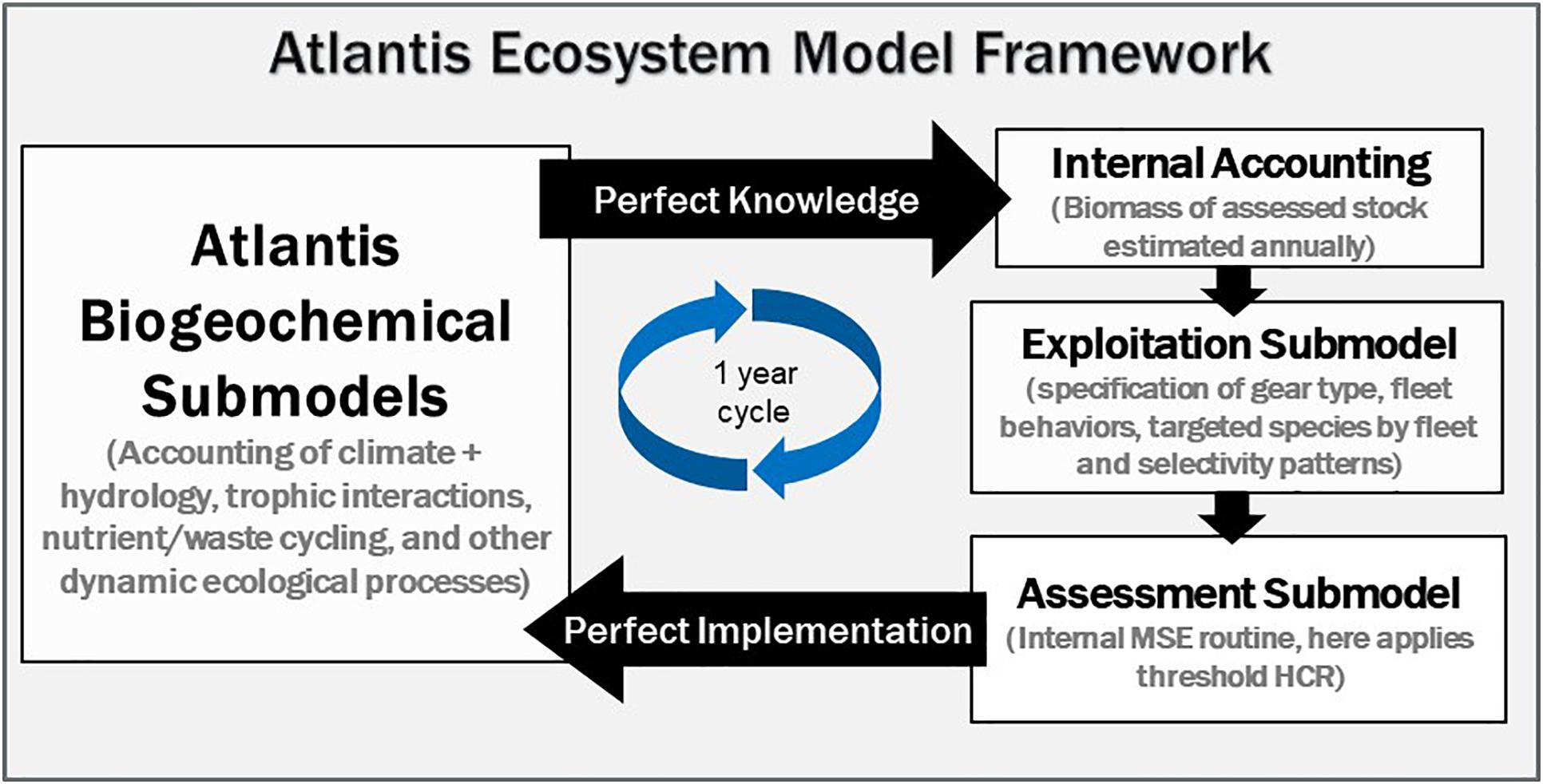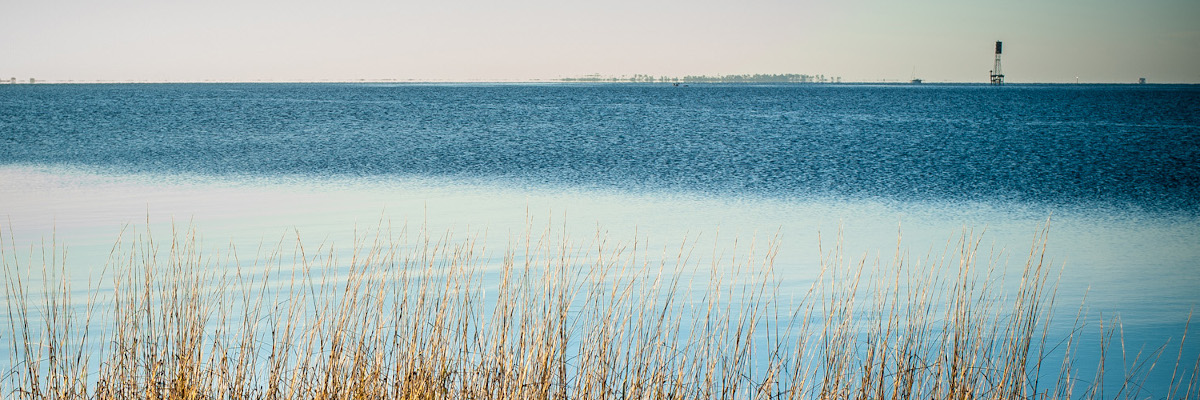The paper "Management Strategy Evaluation: Allowing the Light on the Hill to Illuminate More Than One Species" by Kaplan et al describes several case studies of management strategy evaluations. Below is the Gulf of America case study.
Goal of the Project
The Gulf of America MSE case study implemented a “blanket” harvest control rule to manage six reef fish groups in the Gulf of America, using the Atlantis ecosystem model (Fulton et al., 2004). These reef fish included four species of snappers (Lutjanidae) and groupers (Serranidae) that are managed in the Gulf of America using single-species stock assessments2, an aggregated group of Deep Serranid species, and an aggregated group of Other Lutjanids. However, considering all six reef fish groups can be co-caught by the same fishing gear (Saul and Die, 2016), assessing the efficacy of adapting a blanket policy seemed practical.
The term blanket was used in this application to describe how the chosen threshold harvest control rule considered the available biomass of all six reef fish groups simultaneously – under one “blanket” policy. Although the policy was applied across the reef fish at a species-complex-level, the available biomass of each individual stock was objectively considered, independently, in each iteration of the MSE, before a new fishing mortality rate (F) was prescribed in the subsequent iteration of the simulation. The primary goal of assessing the impact of changes in F at a complex-level was to show the potential benefits of a simple, adaptive management policy that could be applied across a range of co-caught species, while simultaneously accounting for ecosystem dynamics. The Atlantis model was used to explicitly represent biogeochemical processes in three dimensions (Fulton et al., 2004), while also simultaneously capturing interspecific interactions and fleet dynamics, and the role of these dynamic processes in implementing sustainable multi-species fisheries (Masi et al., 2018).
Where in the MSE Loop the Ecosystem Considerations Are Added
The Atlantis model of the Gulf of America was applied as the operating model in the MSE loop. The parameterization and calibration of the operating model is specified in Ainsworth et al. (2015) with diet uncertainty characterized in Masi et al. (2014) and species distributions defined by Drexler and Ainsworth (2013). At each iteration of the Gulf of America Atlantis MSE simulation, the biomass of the assessed stocks was fed internally (at annual time steps) into the Assessment and Exploitation submodels (Figure 6). Atlantis’s Exploitation submodel defines modeled fishing fleets, and was used to parameterize fleet-specific behavior: gear type, targeted species and selectivity pattern (Fulton et al., 2004). The Atlantis Exploitation submodel then supplied the simulated data to the Assessment submodel; note that this submodel was applied because it includes the integrated (“closed-loop”) MSE routine, even though in this case the assessment was assumed to have perfect knowledge of stock size (Figure 6). The Atlantis operating model included trophic interactions, biogeochemical processes and human interaction (via fleet dynamics).

Performance Metrics, Objectives, and Trade-Offs, and How These Were Identified
The Gulf of America Atlantis MSE used ecosystem-level performance metrics that were based on analysis in Masi et al. (2017), which evaluated a suite of Gulf of America ecosystem indicators to assess their efficacy in tracking ecosystem perturbations that are caused by changes in F. Specifically, Masi et al. (2017) found that reef fish catch, Gag Grouper (Mycteroperca microlepis) biomass, and biodiversity metrics were among the top indicators, and these were subsequently utilized to score performance in the MSE. Additionally, ecological trade-offs were quantified by summarizing biomass at the guild level, which for instance illustrated interactions between species groups such as the shrimp, crab and benthic invertebrate guild, the pelagic fish guild, and the “all” reef fish (i.e., the assessed reef fish plus all other reef fish functional groups).
Results
By applying the harvest policy at a blanket-level, the Gulf of America Atlantis ecosystem MSE was able to assess the impact of applying varying levels of F for all six reef fish groups both simultaneously and objectively. High levels of F applied to the reef fish complex, under the threshold harvest control rule, achieved a more Pareto-efficient trade-off frontier, where both higher levels of reef fish biomass and catch were attained (at equilibrium). This Pareto-efficiency was achieved because under higher levels of F, more of the large, carnivorous reef fish (those typically targeted by the fishery) were removed earlier in the simulation. With the largest predators in low abundance, smaller reef fish (those that are co-caught, but not typically targeted among the six assessed reef fish) had more prey available (thus increasing their productivity). This is considered a “cultivation effect,” where a reduction in top predators in the short term (i.e., in this case, the first 1–5 years of the simulation) resulted in increased productivity of the reef fish complex – as a whole, in the long term (Masi et al., 2018). To bracket the uncertainty associated with prey preference, this application utilized the Dirichlet distribution to define 10 alternate parameterizations of trophic pathways (Masi et al., 2014). Results were found to be robust to this uncertainty in trophic interactions and diet. Thus the trophic interactions were critically important in the model projections, but the cultivation effect was consistent across realistic uncertainty in the diet and trophic interactions.
Lessons Learned
In this MSE the biomass ‘observed’ by the Assessment submodel was derived annually using perfect knowledge, and simulated policies were implemented without process error (Figure 6). However, in reality stock assessments are not often performed annually, and assessment and implementation error can be substantial. Therefore the results could be considered a theoretical maximum benefit of applying a blanket, threshold harvest control rule policy to manage these 6 reef fishes. Future analyses should account for operational and implementation uncertainty, such as the ability of fishers and managers to actually achieve a target F, and should vary the number of years between assessment intervals. Typically, under single-species management policies a rebuilding plan would be implemented if the assessed stock fell below an established threshold (e.g., BMSY or biomass resulting from F30%), which is similar to how the threshold harvest control rule operated in this application. However, single-species approaches do not typically account for complex, ecosystem dynamics like the role of interspecific interactions on the available biomass of the targeted stock(s). Therefore, this MSE application offered unique, strategic insight that is not achievable through typical single-species approaches.
